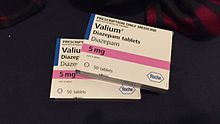Diazepam
Diazepam is an equimolar mixture and it was shown through CD spectra in serum protein solutions, that the 'P'-conformer is preferred by α1-acid glycoprotein binding.
The drug diazepam occurs as a pale yellow-white crystalline powder without a distinctive smell and has a low molecular weight (MW = 284.74 g/mol[16]).
[16] The LogP value indicates that diazepam tends to dissolve more readily in lipid-based environments, such as chloroform, acetone, ethanol and ether, compared to water.
[27] The balance between its lipophilic and hydrophilic characteristics can impact various aspects of the molecule’s behavior, including its solubility, absorption, distribution, metabolism, and potential interactions within the biological system.
The United States Pharmacopoeia lists diazepam as soluble 1 in 16 ethyl alcohol, 1 in 2 of chloroform, 1 in 39 ether, and practically insoluble in water.
[20] Diazepam has several uses, including: Used in the treatment of organophosphate poisoning and reduces the risk of seizure-induced brain and cardiac damage.
[29][43] The anticonvulsant effects of diazepam can help in the treatment of seizures due to a drug overdose or chemical toxicity as a result of exposure to sarin, VX, or soman (or other organophosphate poisons), lindane, chloroquine, physostigmine, or pyrethroids.
[20] Recurrence rates are reduced, but side effects are common and the decision to treat febrile seizures (which are benign in nature) with medication uses these factors as part of the evaluation.
[20] Because of its relatively long duration of action, and evidence of safety and efficacy, diazepam is preferred over other benzodiazepines for the treatment of persons experiencing moderate to severe alcohol withdrawal.
[49] However, benzodiazepines such as diazepam can be used for their muscle-relaxant properties to alleviate pain caused by muscle spasms and various dystonias, including blepharospasm.
They are intended for use in "buddy aid" or "self-aid" administration of the drugs in the field before decontamination and delivery of the patient to definitive medical care.
[20] Infusions or repeated intravenous injections of diazepam when managing seizures, for example, may lead to drug toxicity, including respiratory depression, sedation, and hypotension.
[20][69][70][71] In some people, diazepam may increase the propensity toward self-harming behavior and, in extreme cases, may provoke suicidal tendencies or acts.
[75] Diazepam in doses of 5 mg or more causes significant deterioration in alertness performance combined with increased feelings of sleepiness.
[81] The risk of pharmacological dependence on diazepam is significant, and patients experience symptoms of benzodiazepine withdrawal syndrome if it is taken for six weeks or longer.
[87] Diazepam is seen as a good choice for tapering for those using high doses of other benzodiazepines since it has a long half-life thus withdrawal symptoms are tolerable.
This has been found by measuring sodium-dependent high-affinity choline uptake in mouse brain cells in vitro, after pretreatment of the mice with diazepam in vivo.
The GABAA receptors are ligand-gated chloride-selective ion channels that are activated by GABA, the major inhibitory neurotransmitter in the brain.
[110] The anticonvulsant properties of diazepam and other benzodiazepines may be in part or entirely due to binding to voltage-dependent sodium channels rather than GABAA receptors.
Absorption by any administered route and the risk of accumulation is significantly increased in the neonate, and withdrawal of diazepam during pregnancy and breastfeeding is clinically justified.
[113] Diazepam undergoes oxidative metabolism by demethylation (CYP2C9, 2C19, 2B6, 3A4, and 3A5), hydroxylation (CYP3A4 and 2C19) and glucuronidation in the liver as part of the cytochrome P450 enzyme system.
[29] The elimination half-life of diazepam and also the active metabolite desmethyldiazepam increases significantly in the elderly, which may result in prolonged action, as well as accumulation of the drug during repeated administration.
[115] Diazepam may be quantified in blood or plasma to confirm a diagnosis of poisoning in hospitalized patients, provide evidence in an impaired driving arrest, or to assist in a medicolegal death investigation.
[119] Diazepam was the second benzodiazepine invented by Leo Sternbach of Hoffmann-La Roche at the company's Nutley, New Jersey, facility[120] following chlordiazepoxide (Librium), which was approved for use in 1960.
The benzodiazepines are also far less dangerous; death rarely results from diazepam overdose, except in cases where it is consumed with large amounts of other depressants (such as alcohol or opioids).
[91] Benzodiazepine drugs such as diazepam initially had widespread public support, but with time the view changed to one of growing criticism and calls for restrictions on their prescription.
[122] Marketed by Roche using an advertising campaign conceived by the William Douglas McAdams Agency under the leadership of Arthur Sackler,[123] diazepam was the top-selling pharmaceutical in the United States from 1969 to 1982, with peak annual sales in 1978 of 2.3 billion tablets.
These users often escalate dosage from 2 to 25 times the therapeutic dose of 5 mg to 10 mg.[132] A large-scale study in the US, conducted by SAMHSA, using data from 2011, determined benzodiazepines were present in 28.7% of emergency department visits involving nonmedical use of pharmaceuticals.
Many drivers had blood levels far exceeding the therapeutic dose range, suggesting a high degree of potential for misuse of benzodiazepines, zolpidem, and zopiclone.
[138] A Schedule 4 drug is outlined in the Poisons Act 1964 as, "Substances, the use or supply of which should be by or on the order of persons permitted by State or Territory legislation to prescribe and should be available from a pharmacist on prescription".


